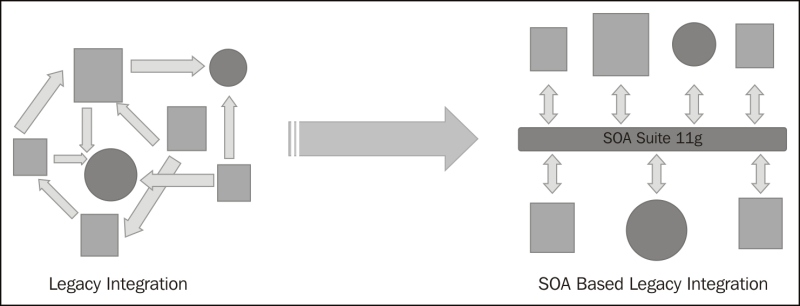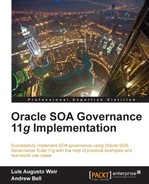The enterprise architecture team, under the guidance of the new CIO, created a compelling business case that was presented in the board of directors at Weir & Bell Telecom. The outcome of this presentation was pivotal to transforming the image of the IT department, which was perceived as being inefficient and slow to react to business changes, and also to secure any needed funding.
SOA was at the heart of the business case. The CIO recognized SOA to be the primary vehicle for introducing the agility required to meet the aggressive demands placed on the IT function by the retail arm of Weir & Bell Telecom. The maturity assessment was an essential part of the business case and it gave the CIO a real understanding of the strengths and weaknesses of his department and allowed him to focus on areas that needed to be addressed immediately. The alignment of IT strategy to business strategy was fundamental to realizing maximum return on investment (ROI) in terms of services and infrastructure.
The business case, together with supporting evidence gathered during the SOA Maturity Assessment, highlighted how real synergy between IT and the business could result in automation and improvement of vital processes in the supply chain. Rationalization of the underlying infrastructure and a move to virtualization, together with the elimination of redundancy in terms of software applications and services across business units, could lead to significant cost savings across the organization.
The following diagram depicts how a governed SOA implementation could significantly reduce the number of integration points and hand-offs between business units, paving the way to increased process efficiencies and cost savings:

The business case discussed how the introduction of Oracle Enterprise Repository to support design-time Governance was essential to ensuring that services were rationalized across the enterprise. Better insight into existing services together with the introduction of design patterns as part of the governance effort would give rise to services that were more granular and more consumable for new processes. This in turn would allow IT to introduce new sales channels by utilizing existing services that communicated with back end order and logistics systems. It described how the reuse of service assets led to the decreased cost of development while the introduction of a new Software Development Lifecycle (SDLC) and continuous integration would lead to better quality software being produced by developers. This in turn would have a huge impact on the test department who were traditionally viewed in a bad light by management. Previously, quality was almost invariably introduced at the testing stage as testers battled with poor quality code leading to a huge testing cycle that in turn led to late delivery of software and increased costs.
The Oracle Enterprise Repository combined with the Oracle Service Registry to enhance runtime Governance allowed Weir & Bell Telecom to share its services with third parties and preferred suppliers, leading to further efficiency savings in the supply chain processes. It illustrated how a large number of requisitions could be automatically raised when supplies fell below a threshold value; depending on business rules, some could even be automatically approved and sent to suppliers without human intervention. This would lead to much smoother delivery of important components and reduced component lead time while allowing the manufacturing department to have a far better control of inventory; all key factors in allowing the business to react to successful marketing and sales campaigns.
Subsequent sections of the business case focused on justifying the cost of implementing governance and illustrated how the benefits would outweigh any spending in a relatively short period of time. This provided the board with key metrics for return on investment. It documented how savings could be realized in different areas. For example, on the current SOA implementation there was little or no reuse of existing services. Huge savings could be realized in the software development costs (CAPEX), by promoting code reuse by strict design-time Governance and by enforcing policies using Oracle Enterprise Repository.
The business case also showed how reuse and policy enforcement would have a positive impact on operating support costs (OPEX), since with proper governance the number of services would increase gradually and not exponentially. Therefore, fewer people are required to support the services and also tasks that are usually complex, such as troubleshooting, would become more predictable since all services would implement known patterns and utilize a common exception handling framework. It is further explained that, by employing Oracle Web Services Manager (OWSM) to secure services in the production environment, the code itself could be separated from the security implementation, bringing with it the ability to declaratively define security for all service implementations, and delegate definition of security policies to the security department. OWSM also provided the ability to monitor whether SLAs were being met.
Another key justification presented in the business case centered around how critical business logic embedded in old and extremely complex legacy systems could be extracted and presented as web services, and could be utilized in key value chain processes. The SOA layer would be used to provide an abstraction layer between legacy systems and the business processes themselves. This would allow the legacy applications to be replaced at a later date without having to change the process itself. The impact of change would be absorbed by the service implementation and transformation logic, the process being unaffected as the service interface would not change. This would, in turn, facilitate legacy modernization that was attractive to the board of directors and it served to illustrate how SOA could be used in different ways to deliver business benefits.
Moving forward, all service implementations would be written to exacting standards to ease their consumption in the future processes and Oracle Enterprise Repository would act as a single source of truth for the SOA portfolio. Architects and analysts would be able to use the repository for version control, dependency tracking, impact analysis, and service discovery and cataloging. In short, the entire service lifecycle would be properly governed both at design-time and at runtime.
The business case concluded by explaining how SOA Governance would lead to better management of the heterogeneous SOA landscape and would deliver greater visibility of end-to-end service networks and better tracking of usage, allowing the IT department to report on return on investment for SOA assets across the enterprise. All of this would ultimately transform into benefits to the business in the form of costs savings and greater flexibility. In short, a win-win situation for the business.
The business case was presented to the board of directors and the feedback was very positive. The budget to begin the roadmap activities was approved. However, the board demanded that all benefits, as documented on the business case, should be supported with critical success factors that could be measured at different checkpoints throughout the SOA program.
